
scrounge: /skrounj/ informal verb: to actively seek [books] from any available source
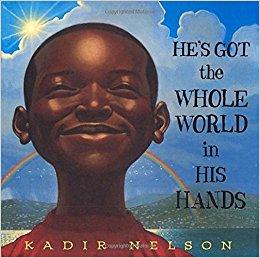
The song He's Got the Whole World in His Hands was one of my favorites to sing as a child, but I never knew it was originally a spiritual.
Sometimes it's a nice change (and a lot of fun) to sing a picture book instead of just reading it, especially with small children. Kadir Nelson has created some wonderful images to accompany the song, focusing on a boy and his family as they interact with nature and with each other, creating a vision that reaches from the individual person to the planet as a whole.
Scrounged From: Our local library
Format: Hardcover
Author: Unknown
Illustrator: Kadir Nelson
Pages: 32
Content Advisory: None
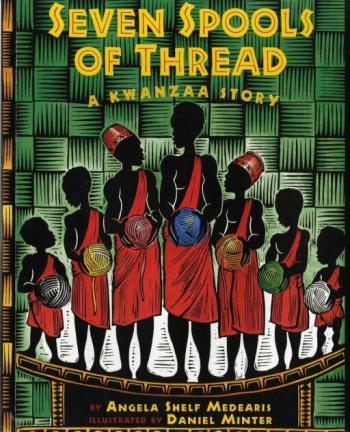
Christmas may be over, but Kwanzaa begins today, December 26 (and runs through January 1), so today's post will feature a children's book that tells a Kwanzaa story. Seven Spools of Thread begins with a brief introduction to Kwanzaa as well as to the seven principles it incorporates.
The story is about a father in Ghana whose seven sons argue with each other from sun-up to sun-down. When their father dies, he leaves them seven spools of thread, and tells them that they will not be allowed to inherit his property unless they can turn the thread to gold by the time the moon rises that night. The brothers are stunned and realize they will have to learn to work together.
I thought the story did a good job of communicating cooperation especially, and how its benefits can be far reaching. The story feels very much like a folktale, and the illustrations are bold and vibrant. The note at the beginning of the book says that all seven principles of Kwanzaa (called the "Nguzo Saba") are incorporated into the story in some way, and so it is an interesting challenge for the reader to try and identify the place(s) where each appears. This is a good example of storytelling that is simple but also thoughtful -- introducing some moral ideas without hitting the reader over the head with them.
At the end of the book, a tutorial on weaving is included.
Scrounged From: Our local library
Format: Hardcover
Author: Angela Shelf Medearis
Illustrator: Daniel Minter
Pages: 40
Content Advisory: None
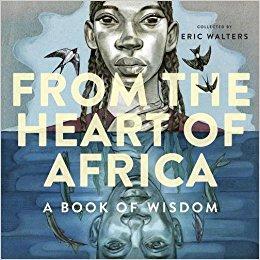
From the Heart of Africa: A Book of Wisdom is a short picture book that includes some sayings/proverbs/aphorisms from people groups on the African continent. As the foreword notes, since aphorisms are universal, the ones found in one region are often similar to those found in other parts of the world, but each is a unique attempt to distill life experience into a short proverb that can communicate wisdom.
Each of the fifteen sayings are illustrated by different artists -- most of whom are from African countries or Canada. The variety of styles and color schemes helps illustrate the diversity of oral cultures that these traditional sayings originate from. Each one also includes a general source (at least to the extent that this can be known), and a brief explanation of the saying.
I like how some of these sayings are familiar ("Many hands make light work"), while others seem more unique ("I pointed out to you the stars, but all you saw was the tip of my finger"). There is also a good mix of proverbs that celebrate community, along with others that encourage independence and creativity.
(Thanks to NetGalley for the review copy.)
Scrounged From: NetGalley
Format: Kindle
Author: Eric Walters
Illustrators: Many! Each illustrator is identified with a brief bio at the end of the book.
Pages: 38
Content Advisory: None
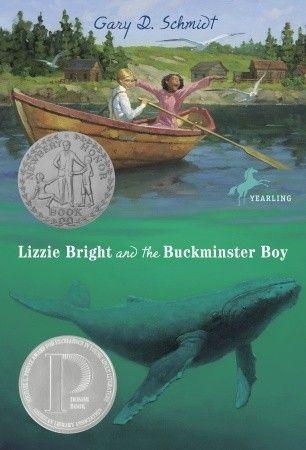
Book Scrounger's note: The following is a guest review by Doug, a.k.a. Professor Puzzler.
So many books I read end up getting lost in the recesses of my mind, and if you asked me sixth months later what I had read, I wouldn't be able to tell you much about the book. Lizzie Bright and the Buckminster Boy will, I think, stay with me for a very long time. This is the story of a friendship between a preacher's son and a pauper black girl from a small island off the coast of Maine.
My wife found the book at Goodwill, and bought it because it takes place in our home state, and because it is a Newbery Honor book.
I started reading it and was hooked from the very first page. The main characters (Lizzie Bright and Hunter Buckminster III) are such believable characters, and I had a sense -- which I seldom get from fictional books -- that these were real, honest-to-goodness people. My perceptions were shaped, perhaps, by the fact that I'm from Maine, and know the places described in the book.
But it wasn't until I was several chapters in that I suddenly realized that this book was only partly fictional. It is the story of one of Maine's most shameful historic events. It is the story of Malaga Island, and the state's decision to remove the island's slave-descended and mixed-race residents and place them in a home for the feeble-minded, where they lived out the remainder of their tragic lives.
Here are some of the things that I loved about this book:
- The descriptions of the Maine coast, community, and church life.
- Believable character interactions and ever changing relationships.
- In keeping with #2, a recurring theme of forgiveness (not explicitly mentioned, but clearly evident).
- Characters who don't always do exactly what you expected them to.
- The depictions of human selfishness, along with selflessness and courage.
- The sprinkling of humorous moments and funny dialogue in the midst of a difficult story.
When I see "Newbery Honor," I automatically think, "book for kids," but this is a book for older kids. It has also won "young adult" awards. The story, being based around tragic historic events, is very dark at times, and as you can probably deduce from what I've said so far, does not have a happy ending.
But it is a powerful book, and it deserves a place in your reading list. There is much more I could say about the book, but I don't want to spoil too much of it for you, so I'll stop here.
I have a feeling this will be one of those rare books that I'll come back to someday and read for a second -- maybe even a third time.
Scrounged From: Our local Goodwill store
Format: Paperback
Author: Gary D. Schmidt
Pages: 224
Content Advisory: Some violence, and depictions of white supremacist attitudes and actions.
During my later elementary years, I really enjoyed reading the historical book series of The American Girls Collection, produced by Pleasant Company. As an adult, there are some I like more than others now, but Addy, written by Connie Rose Porter, is still my favorite. These series give girls (and boys too!) the opportunity to learn about history through characters close to their own age. The original series all follow the same six-book formula, and though the main characters are all growing up in different time periods, they all display courage and hope in various ways.
Each book contains many realistic illustrations, and a "Looking Back" section after the story that includes photographs and drawings, to give some more historical context to the setting and events described.
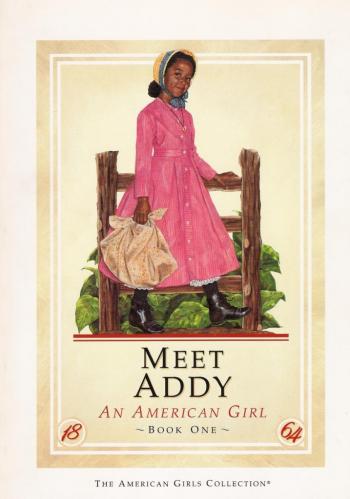
Meet Addy:
In the first Addy book, we are introduced to Addy, a nine-year-old girl who is a slave on a plantation near the end of the Civil War. But in the very first chapter, Addy lies awake at night and listens to her parents talk about freedom -- they plan to run away. But before they get the chance, Addy's father and brother are sold. Addy's mother makes the difficult decision to run away anyway, and leave her one-year-old baby behind with Addy's aunt and uncle, hoping that the family will all meet up again in Philadelphia someday.
Reading this as an adult/parent has a whole different dimension to it. While this series obviously does not even begin to touch on all the horrors of slavery, reading about the punishments and family separations still had an effect on me as a child, and this story made it seem much more real than a history textbook could have.
Looking Back: This section gives a brief history of slavery in the US, as well as the underground railroad and Harriet Tubman, and the beginnings of the Civil War.
Addy Learns a Lesson:
This story is about Addy's introduction to school, and we get to see her navigate the difficulties of getting an education, and of friendship. Addy and her mother arrive safely in Philadelphia, but have almost nothing. They find help and hospitality at a church, and are soon able to earn a living, though making ends meet is difficult. But Addy is determined to learn how to read, and her determination begins to pay off. In addition to learning to read, she learns about what is most important in her friendships.
Looking Back: This covers the difficulties that African-Americans had in obtaining an education during this time (and previously), and the formation of some of the earlier schools.
Addy's Surprise:
Addy and her mother are working very hard, but they are still having a hard time affording basic necessities. Still, as Christmas arrives, they both want to find ways to surprise each other. Even in the midst of their difficulties, Addy is faced with the realization that there are still so many others that are worse off than her and her mother, and both she and her mother do their best to help with what little they have. At the end, Addy recieves a wonderful Christmas surprise as one of her family members reunites with her and her mother again.
Looking Back: Holidays were much simpler in this era anyway, but during the Civil War, most families could not afford "extras." Still, many found ways to make their Christmas celebrations meaningful and festive. This section also touches on the celebration of Juneteenth, as well as the later introduction of Kwanzaa.
Happy Birthday, Addy!:
In this story, Addy meets an elderly woman named M'dear, who is blind. Despite the fact that she can't see, M'dear is able to perceive more than she appears to. Since Addy was born into slavery, she doesn't know what day she was born on -- only that she was born in the spring. M'dear encourages her to "claim" a birth date -- when she finds a day that feels right to her.
Addy continues to learn and hope and work at her education, but the streets of Philadelphia sometimes teach her some ugly things -- that she and others like her can be freely discriminated against just because of the color of their skin. Still, the story ends on a positive note, with hope that someday things will get better.
Looking Back: This section covers certain lifestyle issues of the time period: birth, children's games, education, jobs, and the way the Civil War affected families.
Addy Saves the Day:
Addy and her family are working hard to earn extra money, still holding out hope that their remaining family members will be found soon. Meanwhile, their church puts on a fair to raise money to help wounded soldiers, widows, and separated families. Addy and her friends choose to make spool puppets and put on a puppet show. But not all of her friends are easy to work with. The fair goes well, but when something goes wrong, Addy chooses to take action. At the end, she gets a wonderful surprise.
Looking Back: This section talks about city parks and other public recreation during this era, and about things families did during their leisure time.
Changes for Addy:
The Walker family has been steadfastly searching for the rest of their remaining family members. Addy has been writing letters and not hearing anything back, which is discouragaing, but she never gives up hope. Then one day, she receives an answer, and is sure that very soon, their family will be whole again. She is mostly right, but also has to suffer the pain of loss, as so many other families do.
Addy's experience is also contrasted with her friend Sarah's, which was unfortunately common. While Addy makes good progress with her education and hopes to be a teacher someday, she is saddened when her friend Sarah has to drop out of school in order to earn enough money for her family to pay their rent. In the midst of the hope and determination, it is important to see this side of things too, that some people, as Sarah's mother puts it, "got to eat today and pay for this here room tomorrow. We can't be dreaming about someday."
The story ends with Addy reading the Emancipation Proclamation at her church.
Looking Back: After the Civil War, Reconstruction brought many advancements for African-Americans, but not all of it lasted -- the South soon instituted "black codes," and made segregation worse. This section concludes with an overview of the Civil Rights movement, up through the life of Martin Luther King Jr.
As much as I like this series, it is still worth pointing out to children that Addy is fortunate in many ways: she is able to stay in school and obtain an education, and she is able to at least discover the fate of all of her missing family members, which was not the case for many children who were in a similar situation.
Scrounged From: A birthday present from my childhood


